American PT-ACS since the war (part 3) - M36 Slugger
History create
In October 1942, the US military decided to consider the option of installing an 90-mm anti-aircraft gun on the ACS. Initially, this project pursued more theoretical goals, but soon became really necessary. The 90-mm cannon was installed on the tank destroyer at the start of the 1943. The new gun was significantly longer and on 300 pounds heavier than the 76-m gun PT-SAU M10. It became obvious that it required a larger tower with a more powerful turning mechanism.
Work on the wooden model of the tower, specially designed for the installation of 90-mm guns, began in March 1943 year. The company Chevrolet was engaged in the development, the finished mock-ups of the towers were sent to Ford, which manufactured the 2 experimental towers from non-armored steel. An important difference in them was how the problem of length and considerable weight of the 90-mm gun was solved. On the M10, the weight of the 76-mm guns was compensated using special metal weights with a total weight of 3600 pounds (1600 kg.), Which were mounted on the rear wall of the tower. On the new tower, a large steel box, located at the back and serving to place the first round of gunfire, acted as a counterweight.
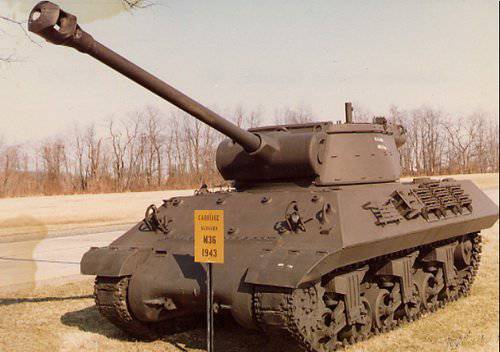
Reservation tower has been increased. The developers have created a new swivel mechanism with the possibility of manual traverse. The crew was located in the tower as follows: the commander to the left of the gun behind the gunner, to the right of the gun - loader. Initially, a ring turret was installed on the left to install a large-caliber machine gun. Two created prototypes SAU Т71 based on М10 and Т71Е1 based on М10А1 were sent for testing at the Aberdeen testing ground.
During the tests, the customer demanded a number of changes: place the gun ammunition in the sponsons, replace the ring turret of the anti-aircraft machine gun on the pin machine at the stern of the tower, improve the equipment of the tower. After making changes, the prototypes passed repeated tests, during which the military made new observations. The main one concerned 90-mm guns. When firing from it there was a strong flash and thick dust was raised. In order to solve this problem, it was proposed to install a muzzle brake on the gun and use other ammunition.
By November 1943, the work on the new tank destroyer was completed. A limited series of machines were ordered in 500 T71 GMC, which were supposed to be converted from M10A1 at the Fisher plant. From April to July, 1944 was able to produce only 300 machines, but the need for a PT-ACS with an 90-mm gun was so great that it was decided to connect the Massey Harris Company to speed up production. From July to December, the 1944 of the year brought together more 500 tank destroyers converted from the M10A1. In July, the 1944 of the T71 prototype was finally standardized and received the designation M36 Slugger (slugger term from boxing, a boxer with a strong blow).
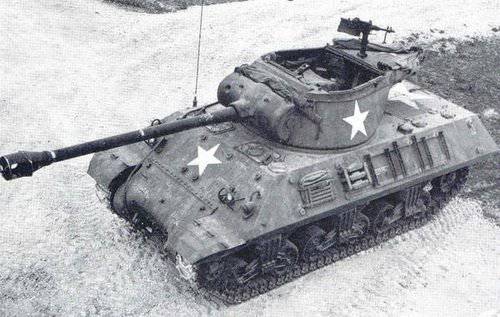
In the meantime, the acute need for M36 Slugger PT-ACS has only increased. The fighting in Normandy demonstrated that the 76-mm gun M10 is not able to successfully fight with the German tanks Tiger and Panther. The Shermans were also not suitable for anti-tank combat, as they were armed with the same 76-mm gun. Under the circumstances, the M36 was the only American machine that could more or less successfully fight German heavy tanks. With the advance shaft, there went the demands to send them the M36, a real boom broke out in the troops for this tank destroyer.
Trying to meet the growing need of the army for self-propelled guns, the Americans went to extreme measures - they installed a tower with an 90-mm cannon on the hull of their medium-sized M4-3 Sherman tank. The new machine was standardized in October 1944, and received the designation M36B1. From the point of view of the American concept of tank destroyers, this car turned out to be heavy and not fast enough.
However, it was this self-propelled gun that was probably the best in the American army. Reservations medium tank and 90-mm gun successfully combined. PT-SAU M36B1 became the most armored American self-propelled gun of the Second World War, as well as the only one with a machine gun exchange rate. With these forced “shortcomings”, the car approached German and Soviet common requirements as closely as possible to have a good reservation, a powerful weapon and a protective machine gun to fight the enemy’s infantry. However, the Americans continued to adhere to their flawed defense concept against tank destroyers until the end of the war. From October to December, Fisher's 1944 workshops left only the M187B36 1 SAU.
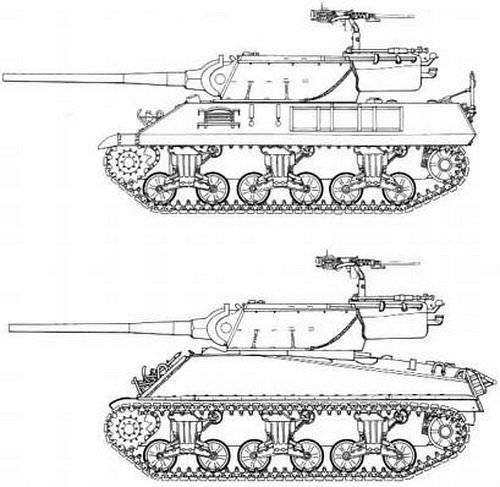
By the end of 1944, the supply contracts for the M36 and M36B1 were closed, but the troops still needed these machines. The M10А1 cases that converted to the M36 have also come to an end. Under these conditions, the latest version of this machine М36В2 created using М10 case went to the series. In this project, many problems of previous versions were solved. The internal structure of the PT-SAU has undergone many minor changes, the gun received a large muzzle brake, on the part of the serial machines the open top of the tower was closed with steel flaps.
Design features
The M36 Slugger PT-ACS had a differentiated counter-spun armor using rational tilt angles and a combat compartment open at the top. Depending on the version, the ACS had different versions of the M36 and M36B2 hulls from the M10A1 and M10 SAUs, and the M36B1 modification was from the M4A3 tank. The armored hull of the M10 ACS was a rigid supporting box construction that was assembled from rolled sheets of armor steel by welding, and cast armor parts were used in it. The upper frontal part was 38 mm thick and positioned at an angle of 55 ° to the vertical. The lower frontal part was a cast transmission housing and had a similar tilt angle. The lower part of the hull sides had a thickness of 25 mm, the top was assembled from 19-mm armor plates, placed at an angle of 38 °, booking of the stern was also 19 mm. The roof of the hull in the area of the turret box had an 19 mm reservation, in the area of the engine compartment - 10 mm. The bottom of the self-propelled gun was 13 mm thick. Additional reservations were 6-mm screens that covered the upper branch of the tracks.
The hull of the M4A3 had a similar design, but had a more substantial reservation. The upper frontal part of the hull had a thickness of 64 mm and the angle of inclination of the armor 47 °, the transmission cover repeated the part M10. The onboard booking was 38 mm, while the upper part of the sides was vertical, with the exception of bevels in the area of the engine compartment. Reservation aft hull was 38 mm. The roof of the case was assembled of armor plates with a thickness of 19-mm, and the bottom was made of 25-mm plates in front of the machine and 13-mm in the area of the engine compartment of the SAU.
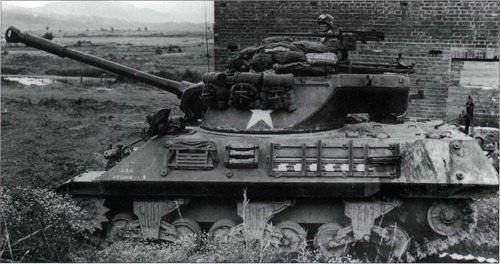
The fully cast ACN MXX tower was the same for all modifications and had a cylindrical shape with a well-developed feed niche. The sides of the tower had a reservation at 36 mm. The forage of the tower's niche, acting as a counterweight, was 32 mm thick. The frontal part of the tower had a complex shape and was covered with a cast mask of a gun with a thickness of 127 mm. The ACS tower was open at the top, but a small section of its frontal part and aft niche had a roof from 76 to 10 mm thick.
The basic one weapons The M36 Slugger PT-ACS was an 90-mm M3 rifled semi-automatic rifle based on an anti-aircraft gun. The gun was equipped with a vertical wedge gate, the barrel length was 50 gauges (4500 mm). To ensure the accuracy and smoothness of the vertical guidance, the gun was equipped with a spring-type compensator. The gun's rate of fire was 8 rds / min. The angles of vertical guidance of the instrument ranged from −10 ° to + 20 °. The vertical guidance of the instrument was carried out manually, the horizontal was provided by turning the turret using an electro-hydraulic or redundant manual drive. The speed of rotation of the tower was 24 degrees / sec.
The maneuverability of self-propelled fire increased significantly compared with its predecessors through the use of an electro-hydraulic drive of horizontal pickup instead of a manual one. Due to this, the ACS was equated with the base Sherman tank. Along with this, the M36 was still equipped with the relatively primitive M76D telescopic hinged sight, which had an 3-fold increase and field of view in 21 °. At the same time, the later-series Sherman base tanks were equipped with a more sophisticated T8 periscope sight, which had an 6 multiple increase, while a specialized tank destroyer armed with a powerful, long-range 90-mm gun kept the simplified sight. Although the telescopic sight, rigidly attached to the gun mount, had its advantages, for example, greater accuracy due to the lack of articulated joints between the sight and the gun.
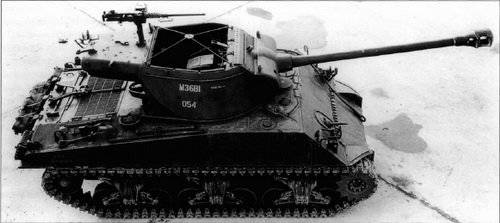
Depending on the modification, the M36 could be equipped with several engine options. M36 and M36B1 had a V-shaped 8-cylinder aviation 450 hp carbureted liquid-cooled engine The fuel for it was gasoline with an octane rating of at least 80. The engine air exhaust system included 2 cyclone-oil type air cleaners. The cooling system consisted of 2 fans and 2 radiators, which were located in the rear of the engine compartment. The engine was started using the starter. On the version of the tank destroyer M36B2, which was based on the M10 chassis, the power plant consisted of 2 in-line 6-cylinder liquid-cooled diesel engines, the power of the installation was 375 hp. Auxiliary engine systems were generally similar to other versions of self-propelled guns, but differed in the presence of 3 air purifiers.
At M36 PT-ACS, there was an 4 fuel tank with a total volume of 727 liters. The fuel tanks were located in the engine compartment sponsons: 2 front 150 l. and left and right rear capacity 208 and 219 l. respectively. M36B1, based on the base of the tank, the M4A3 had a slightly different arrangement of fuel tanks: 2 vertical on the sides of the engine and 2 in the sponsons of the hull. Their capacity ranged from 636 to 659 liters. On the M36B2 the fuel tank capacity was 625 liters.
Performance characteristics: М36 Slugger
Mass: 28,5 t.
Dimensions:
Length 7,455 m., Width 3,48 m., Height 3,03 m.
Crew: 5 people.
Reservations: from 10 to 51 mm.
Armament: 90-mm M3 rifled gun
Ammunition: 47 shots
Engine: V-shaped 8-cylinder carburetor liquid cooling, hp power 450
Maximum speed: on the highway - 42 km / h
Power reserve: on the highway - 280 km.
Sources used:
www.vn-parabellum.com/us/m36-art.html
www.pro-tank.ru/bronetehnika-usa/samohodnie-ustanovki/166-m36-slagger
www.tank2.ru/country/usa/sauusa/slaggerm36
www.all-tanks.ru/content/samokhodnaya-artilleriiskaya-ustanovka-m36-%C2%ABslagger%C2%BB-ili-%C2%ABdzhekson%C2%BB
www.rus-wot.ucoz.ru/publ/tanki_ssha/pt_sau_m36/9-1-0-70
Materials free online encyclopedia "Wikipedia"
Information